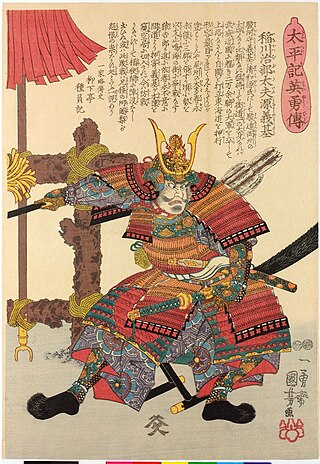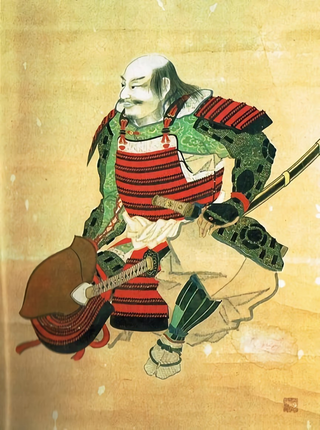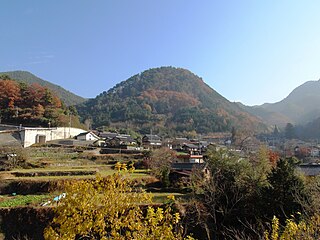
Imagawa Yoshimoto was a Japanese daimyō of the Sengoku period. Based in Suruga Province, he was known as The number one Daimyō in the Tōkaidō; he was one of the three daimyō that dominated the Tōkaidō region. He died in 1560 while marching to Kyoto to become Shogun. He was killed in the village of Dengakuhazama in Okehazama by Oda Nobunaga.

Takeda Shingen was daimyo of Kai Province during the Sengoku period of Japan. Known as the "Tiger of Kai", he was one of the most powerful daimyo of the late Sengoku period, and credited with exceptional military prestige. Shingen was based in a poor area with little arable land and no access to the sea, but he became one of Japan's leading daimyo. His skills are highly esteemed and on par with Mōri Motonari.

Murakami Yoshikiyo was a Japanese samurai from the Murakami clan and retainer of the Uesugi clan during the Sengoku period of the 16th century. Yoshikiyo followed in fighting against both Takeda Nobutora and his son Takeda Shingen. Yoshikiyo was also a very close ally under Uesugi Kenshin and one of Shingen's bitterest opponents for his high kill-counts in their conflicts.

Itagaki Nobukata was a retainer of the Takeda family. He was known as one of the "Twenty-Four Generals of Takeda Shingen". His name is also seen with different kanji as 信形. Nobukata served under both Takeda Nobutora and Takeda Shingen and also was tasked with young Shingen.

Takeda Nobutora was a Japanese daimyō who controlled the Province of Kai, and fought in a number of battles of the Sengoku period. He was the father and predecessor of the famous Takeda Shingen.
Hiraga Genshin was a retainer to the Takeda family towards the beginning of Japan's Sengoku period (1467–1615). He was attacked by Takeda Nobutora at Un no Kuchi in 1536, and forced Nobutora to retreat. But Nobutora's son, Takeda Shingen, then 15 years old, and called 'Takeda Harunobu', rallied the Takeda forces and led them to victory, killing Hiraga in the process.

Takeda Nobukado was a Japanese samurai (warrior) and general of the Takeda clan during the Sengoku period. He was known as one of the "Twenty-Four Generals of Takeda Shingen". He is also well known as a painter.

Takeda Nobushige was a samurai of Japan's Sengoku period, and younger brother of Takeda Shingen. He was known as one of the "Twenty-Four Generals of Takeda Shingen".

The Takeda clan was a Japanese samurai clan active from the late Heian period until the late 16th century. The clan was historically based in Kai Province in present-day Yamanashi Prefecture. The clan reached its greatest influence under the rule of Takeda Shingen, one of the most famous rulers of the period.

The Battle of Sezawa was the first major battle fought by Takeda Shingen in his campaign to gain control of Shinano Province. He took on and defeated a coalition of Shinano daimyō including the leaders of the Suwa, Ogasawara and Murakami clans.

Naitō Masatoyo also known as Naitō Masahide was a Japanese samurai of the Sengoku period. He was known as one of the "Twenty-Four Generals of Takeda Shingen". Masatoyo was the second son of Takeda Nobutora's senior retainer, Kudō Toratoyo. He was first called Kudō Sukenaga. The family's fortunes fell when Toratoyo lost favor with Nobutora and was killed by him.
Suwa Yorishige (諏訪頼重) (1516–1544) was a Japanese samurai, daimyo of Shinano province and head of the Suwa clan. He was defeated by Takeda Shingen, and his daughter Suwa Goryōnin was taken as Shingen's concubine. She later gave birth to the Takeda clan heir Takeda Katsuyori.

Sanada Yukitaka was a Japanese samurai warrior of the Sengoku period. He is known as one of the "Twenty-Four Generals of Takeda Shingen". He was the father of Sanada Nobutsuna and Sanada Masayuki and grandfather of the legendary samurai warrior Sanada Yukimura of whom served Toyotomi clan.
The 1546 siege of Uchiyama was one of many battles fought by Takeda Shingen bid to gain control of Shinano Province. His troops surrounded the fortress and starved out the garrison.
The siege of Shika castle, which took place in September 1547, was one of many battles fought in Takeda Shingen's bid to seize control of Shinano Province.

The 1547 Battle of Odaihara was one of a series of battles waged by Takeda Shingen in his long campaign to conquer Shinano province. In this particular encounter he was fighting the forces of Uesugi Norimasa, who was based in Echigo province but had decided to intervene in Shinano to prevent Shingen from overrunning the whole province. The Uesugi army attempted to relieve the castle of Shika, which Shingen had besieged, but were attacked and defeated at Odaihara on 19 September 1547.
In the history of Japan, the 1582 siege of Takatō (高遠城の戦い) was one of the final battles of the Takeda clan against the forces of Oda Nobunaga. The only Takeda stronghold in Shinano province to put up any resistance to Nobunaga's final invasion of Takeda domain, the castle was taken by storm on March the 2nd 1582.
Fūrin Kazan (風林火山) is the 46th NHK Taiga drama television series that began on January 7, 2007. It was aired throughout 2007, with the last episode aired December 16, 2007. Its official English title is The Trusted Confidant.

Nobuzane (武田信実) more commonly known as Kawakubo Nobuzane was a younger half-brother of Takeda Shingen, a preeminent daimyō who vied for the control of Japan in the late stage of Sengoku, the "warring states" period. He was also called Kawakubo Nobuzane because he was raised in Kawakubo village.

Yōgaiyama Castle was a Sengoku period yamajiro located in Kai Province, constructed in the 1520s by the Takeda clan. Since 1991, the ruins have been protected as a National Historic Site since 1938. The castle is also known as the Sekisuiyama Castle.














